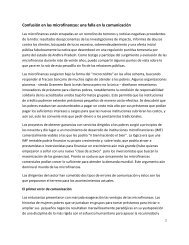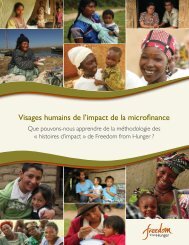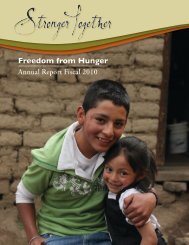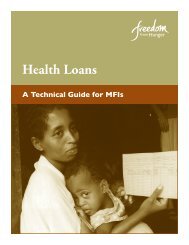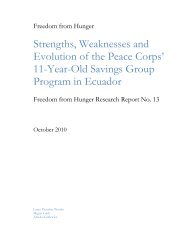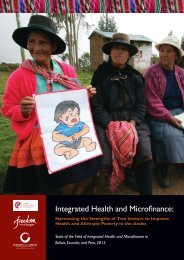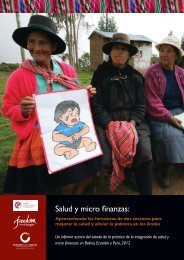history of meals for millions, soy, and freedom from ... - SoyInfo Center
history of meals for millions, soy, and freedom from ... - SoyInfo Center
history of meals for millions, soy, and freedom from ... - SoyInfo Center
Create successful ePaper yourself
Turn your PDF publications into a flip-book with our unique Google optimized e-Paper software.
qualified (by personal participation) to do so... [I] I have<br />
done considerable preparatory work among the voluminous<br />
files which Florence [Rose] rescued in 1964.” Starts with a<br />
few definitions.<br />
“Preliminary–personal: Prior to my contacts with<br />
Clif<strong>for</strong>d Clinton (1939) my education <strong>and</strong> experience were<br />
unrelated to food or nutrition or biochemistry. I did not<br />
know what a <strong>soy</strong>bean looked like. I had received academic<br />
education in liberal arts, a law degree <strong>from</strong> George<br />
Washington Univ. (Washington, DC)–Service in the 1st<br />
World War (Intelligence Headquarters, 1st Div., 1st Corps<br />
<strong>and</strong> 1st Army) (Feb. 18, 1918 to Nov. 13, 1919). Prior to<br />
discharge I was with American School Detachment, Univ. <strong>of</strong><br />
Paris, faculty <strong>of</strong> laws... was employed by Clif<strong>for</strong>d Clinton in<br />
his municipal campaign to recall Mayor Shaw <strong>and</strong> elect<br />
Fletcher Bowron. [After that] I went to Washington again<br />
<strong>and</strong> was able (through connections there) to help Clinton get<br />
assigned to Quartermaster General as a Civilian Consultant<br />
on military problems. In 1944 Clinton worked out a big plan<br />
<strong>for</strong> national restaurant operation–which led me into contact<br />
with American food operations (General Foods, General<br />
Mills, etc.) but more <strong>and</strong> more my political direction<br />
became redirected into helping carry <strong>for</strong>ward Clinton’s<br />
restaurant operation idea–through a Food Service Training<br />
School he operated at Clifton’s [cafeteria] <strong>for</strong> a year or<br />
more.<br />
“In the course <strong>of</strong> his work while in Washington [DC]<br />
(during the depression years <strong>and</strong> prior to the development <strong>of</strong><br />
government relief programs) Clinton noted various articles<br />
in the press <strong>and</strong> special publications that dealt with the<br />
possibility <strong>of</strong> developing new foods <strong>from</strong> materials less<br />
costly than those that prevailed in the American diet. In his<br />
restaurants he had experimented successfully with serving<br />
pre-prepared <strong>meals</strong> <strong>for</strong> 25¢ <strong>and</strong> then <strong>for</strong> 5¢–using largely<br />
conventional low-cost foods, distress food <strong>from</strong> the<br />
markets–day-old bread. He even had a 1¢ meal which was<br />
subsidized by himself <strong>and</strong> others <strong>and</strong> by ‘meal tickets’ sold<br />
to Service Clubs <strong>and</strong> Church members who would buy the<br />
tickets <strong>for</strong> 25¢ each <strong>and</strong> then donate them to needy people<br />
who would use them at Clifton’s restaurant to pay <strong>for</strong> their<br />
meal.<br />
“But this was obviously a make-shift adaptation <strong>of</strong><br />
conventional ‘charity.’ Clinton’s reading had led him to<br />
repeated comments that a completely balanced <strong>and</strong><br />
nourishing meal could be provided at very low cost by<br />
using abundant vegetable proteins, synthetic vitamins,<br />
minerals <strong>from</strong> ‘non-food’ sources. It was well known that<br />
during war shortage in Engl<strong>and</strong> calcium <strong>from</strong> the chalk<br />
cliffs <strong>of</strong> Dover had replaced the calcium found in milk.<br />
Principles long recognized in the feeding <strong>of</strong> animals were<br />
receiving attention as a source <strong>of</strong> human nutrition.<br />
“So after much talk <strong>and</strong> correspondence, Clinton wrote<br />
to me (<strong>from</strong> Washington) in 1944 to see if I could find a<br />
biochemist who could (<strong>and</strong> would) develop a food product<br />
MEALS FOR MILLIONS, SOY, AND FREEDOM FROM HUNGER 103<br />
© Copyright Soyinfo <strong>Center</strong> 2011<br />
which would provide complete nutrition (protein, vitamins,<br />
minerals, calories) in a compact <strong>for</strong>m that would cost no<br />
more than 5¢–<strong>and</strong> which could be added to normal deficient<br />
diets (rice, wheat, roots, etc.) without changing their<br />
accustomed flavor–which would be ‘acceptable’ <strong>and</strong> not be<br />
contrary to anyone’s religious belief or social ‘taboo.’<br />
“So I started out–saw a few commercial chemists who<br />
were so busy <strong>and</strong> disinterested that I about gave up until I<br />
noted a new book [1940] on Vitamins by Dr. Henry<br />
Borsook, Pr<strong>of</strong>essor <strong>of</strong> Biochemistry at Calif. Inst. <strong>of</strong><br />
Technology.<br />
“Borsook read Clinton’s specifications <strong>and</strong> told me they<br />
could easily be met–that they had been met in animal feeds<br />
<strong>for</strong> many years–that such food items had been<br />
experimentally developed in laboratories <strong>for</strong> many years but<br />
that the obstacle was the American Food Industry–such<br />
institutions as the Meat Institute, the Dairy interests–<br />
organized to protect the market <strong>for</strong> producers <strong>of</strong> their<br />
special products. He said that Science had <strong>for</strong> a quarter<br />
century been able to provide adequate nutrition at costs far<br />
below what people adequately paid <strong>for</strong> foods... The Dept. <strong>of</strong><br />
Agriculture pleaded farmers’ income first <strong>and</strong> let human<br />
nutrition become secondary to income interests <strong>of</strong> food<br />
merch<strong>and</strong>isers <strong>and</strong> producers.<br />
“‘If Clinton will serve this food in his restaurants I will<br />
develop it here at Cal-Tech... He will have to provide about<br />
$10,000–convert a laboratory into a kitchen, enable me to<br />
hire a cook <strong>and</strong> a laboratory assistant <strong>and</strong> buy some<br />
materials <strong>for</strong> developing the type <strong>of</strong> food he wants–but, he<br />
warned, you will waste ef<strong>for</strong>t <strong>and</strong> time by trying to<br />
introduce this kind <strong>of</strong> food through normal channels <strong>of</strong> trade<br />
in the American wholesale <strong>and</strong> retail market.’<br />
“I wrote the results <strong>of</strong> this interview to Clinton, in<br />
Washington. He returned to Los Angeles with his wife<br />
[Nelda] <strong>and</strong> restaurant associates signed the agreement with<br />
Cal-Tech.<br />
“The laboratory at Cal Tech became a kitchen. A French<br />
cook (Mme. Soulange Berczeller) was employed <strong>and</strong><br />
Josephine Williams (Now, I believe one <strong>of</strong> the home<br />
demonstration personnel in the U.S.D.A.) was the lab<br />
assistant.<br />
“After some experimentation with various vegetable<br />
proteins (alfalfa etc.) Borsook decided that <strong>soy</strong>bean meal<br />
<strong>of</strong>fered the best <strong>and</strong> most abundant vegetable protein<br />
available at a price low enough to enable Clinton to serve<br />
his ‘5¢ meal’ without losing money.”<br />
A few key dates:<br />
1944 Jan. 1–Clinton writes Chamberlain outlining 12<br />
essential characteristics <strong>for</strong> the proposed new food.<br />
1944 May 22–Clinton signs the agreement with Cal-<br />
Tech to develop the new food with the proviso that the<br />
<strong>for</strong>mula should be free to the world. Borsook called the<br />
product Multi-Purpose Food. Thereafter MPF was served at<br />
Clinton’s cafeterias in Los Angeles.



